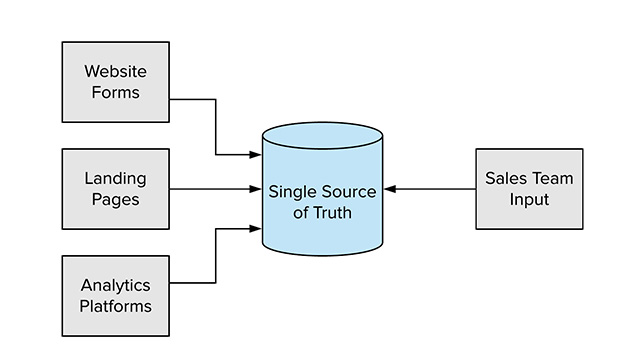What Is Lead to Revenue Tracking in Marketing?

Think of it this way. You’re the marketing director for a software company. Your website gets 1,000 hits a week, and generates 10 leads – a pretty standard 1% conversion rate. Of those, two on average close and consequently start giving you money. Wouldn’t you want to know what engaged those two so you can do more of it? That’s where lead attribution comes in.
L2R Attribution Models
Before we talk about the step-by-step technical aspects of lead to revenue tracking, it’s important to cover the broad strokes. In this case, that’s the concept of attribution models – what you’re measuring against. The “revenue” side of lead to revenue is easy – it’s revenue. The “lead” side is a little harder. What counts as a lead? This is where attribution models come in.
There are any number of different marketing attribution models – some say 11, some say three, some say something else, and all make a cogent case. Here at Altitude, we like to keep L2R management simple. Instead of writing complex models around U paths, Z paths, W paths, touches from specific marketing channels, time decay, linearity, etc., we focus on two critical moments:
- When a prospect first engaged with a brand (the first-touch model), and;
- When a prospect entered the sales funnel with contact information (the MQL model).
The First-Touch Attribution Model
In first-touch lead attribution, we’re measuring what first got a prospect interested in the brand. This could be organic search, PPC advertising, display advertising, earned media, social media, etc. What we’re hoping to measure in this model is the success of various tactics and strategies at raising awareness among qualified buyers.
While first-touch attribution seems simple, it’s actually relatively difficult to execute without expensive, purpose-built tools and automation platforms. This is because you’re left with a gap in your data between a prospect’s first engagement and the moment they turned into a marketing-qualified lead. If you’re not tracking users on a granular basis, you can lose track of individuals. This means that first-touch attribution is typically best used as a supporting lead to revenue management tack, rather than the main thing you’re looking at.
The MQL Attribution Model
MQL lead attribution measures what got prospects to convert – in other words, what made them a “lead.” This is much simpler without complex technology, and it draws a more direct path down the sales funnel. Creating an MQL is about turning a prospect’s interest into buying intent – the most critical transformation in B2B marketing. Naturally, then, this is the crux of lead to revenue tracking for most companies.
Now that we’ve covered the two basic marketing attribution models, let’s look at how to put them into practice.
Lead to Revenue Tracking: Data Transfer
The most important part of effective lead to revenue tracking is establishing a single source of truth that contains both marketing and sales data. For most companies, this is a piece of customer relationship management (CRM) software, but it can also be a marketing automation platform. Either way, it needs to be able to accept inputs from two directions – your marketing tools, and the sales team. The goal here is combining both marketing data (the lead side) and sales data (the revenue side); if you’re missing one or the other, you’re missing the point.
This is a key pain point for many lead to revenue tracking efforts. The rule of thumb: Send over the data you’ll need, but don’t overdo it. You can go crazy with your integration efforts, trying to inform the sales team about every time a prospect opened an email, viewed a web page or thought about your company. Ninety-nine percent of the time, this level of granularity is unnecessary for lead to revenue tracking. Instead, you need to focus on two touch points (as described in the above attribution models):
- The first time they heard about you
- What got them to hand over their contact info
If you can get those two events into your CRM or marketing automation platform, you’re pretty much good to go.
MQL Attribution
The conversion point is easy – usually, it’s just a matter of sending some form data to the system via API, webhook or prebuilt integration. (Hidden fields are great for this.)
Every form builder and system is record is a little different. Gravity Forms, for instance, has add-ons for a ton of systems (e.g., Campfire, Capsule CRM, Agile CRM), but you’ll need to do some extra work – usually with Zapier or a WordPress plugin– to support Salesforce, Marketo or SugarCRM. Unbounce, a best-in-class landing page builder, is similar – some integrations are plug and play, others require a bit of legwork. Either way, the form a prospect fills out can usually carry enough data to fulfill the MQL attribution model.
You’re typically going to want to use the Lead Source field in your CRM or MAP for this data. If that doesn’t jive with your workflows – every company is different – you can create a custom field for “Conversion Point.” This will become important later, when we run reports against it.
First-Touch Attribution
Preserving data on a prospect’s first touch of the brand can be significantly tougher. Marketing automation platforms like HubSpot and Marketo support it out of the box, but with a major caveat: If you’re not embedding their forms, you’re going to lose the first-touch data. In that scenario, the platform usually won’t be able to connect the dots between a prospect’s first visit and when they converted. So if you’re interested in using the first-touch attribution model and want to use an enterprise automation platform to get there, plan on using their forms, not mapping native web forms via API or webhook.
If you don’t have the budget for a marketing automation platform ($1,000/month is table stakes) or one simply wouldn’t fit within your workflows, you’re going to have a much harder time capturing and transferring granular first-touch lead tracking data. Google Analytics’ First Interaction attribution model gives you a decent look at conversions by channel, but with two major issues:
- The first touch might have occurred too long ago to be properly tracked
- The data is holistic, rather than specific to an individual lead
The bottom line, again: If you don’t have an enterprise marketing automation system in place, you’re better off focusing on MQL attribution as your main model. First-touch can add context, but it’s not going to rise to the level of actionable business intelligence.
Making Lead to Revenue Tracking Actionable

The core goal of any lead to revenue tracking effort is understanding where your best (i.e, closed) leads come from. This isn’t just about marketing proving its worth – though that’s certainly a nice benefit. The real function of L2RM is telling marketing what’s working so it can do more of it.
The easiest way to do this is through custom reports in your CRM or marketing automation system. This doesn’t have to be difficult! Every month, simply run a report on new deals (filter your lead, deal or opportunity status by “Closed-Won” or whatever your particular nomenclature is) and be sure to include:
- The buyer
- The type of deal
- The deal value
- The close date
- The lead source
You should end up with a table that looks like this:

What does this mean? Maybe you should create more content about AI, or write more similar blog posts about related content. With a little bit of planning and some simple data transfer, you’ve created real, actionable insights for your team – and helped shape a profitable future.
Do I Need Specific L2RM Software?
We’d argue that no, you don’t need purpose-built lead to revenue management software. There’s lots of talk in the field about L2R automation, but unless your deal volume is extremely high, you’re fine with the basics described here and simple reports sent to Excel. Don’t reinvent the wheel or get too granular – you’ll never attribute revenue to a specific tweet, for instance. Get the broad strokes down and start acting on those new insights!
Need a hand setting up your lead to revenue tracking system … or just need more leads to track? That’s our job! Altitude is a full-service marketing agency serving B2B companies across the globe. We’d love to help you grow. Contact us online, or call 610-421-8601 x122 to get in touch with one of our marketing analytics experts today.





